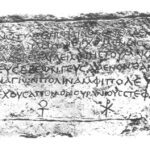| Artefact ID | 1258 |
| TM ID | TM 102825 |
| Findspot (DEChriM ID) | 79 (Armant) | Class | Textual |
| Material | Stone |
| Writing medium | Inscription |
| Text content | Subliterary |
| Language | Greek |
| Description | IGChrEg 423; I.Métriques 60; SB I 5719 : Funerary epitaph of Makareia. Slab of sandstone of which the right side is rounded, measuring h. 20 x l. 55 x w. 7.5 cm. The text is written inside an incised rectangular frame, with a dovetail on the right side. Four crosses in the bottom part (from left to right): one chrism, one staurogram, one crux ansata, one other chrism. The epitaph, written in elegiac distichs (with pentameters in eisthesis), commemorates the "unforgettable Makaria", whose "body tasted death as is usual for pious people", while "she [=her spirit] is the servant of the heavenly city of the saints, having as a reward for her sufferings the heavenly wreaths". Bernand notes that the poet is mixing traditional elements of pagan epigrams with formulas taken from the New Testament. About the wreaths as a reward for martyrdom and for chastity, see also SB IV 7315 and Papaconstantinou 2001: 378-379. |
| Selection criteria | Mention of Christian individuals/communities, Christian terms/formulas/concepts, Christian symbols/gestures/isopsephy, Biblical quote or paraphrase |
| Date from | 350 |
| Date to | 450 |
| Dating criteria | Palaeography. Dated 4th c. in Lefebvre : xxxiv but the use of the staurogram makes it most unlikely that it was written before 350 (Bernand 1969: 246). |
| Absolute/relative date | Relative date |
| Archaeological context | Keene 1892:[295]: "Brought from Upper Egypt last spring. It was said to have been found at Erment, the ancient Hermonthis, a few miles above Luxor, and it was in the neighbourhood of that place I obtained it". |
| Accession number | Cork, Private collection Keene number unknown |


 Json data
Json data




